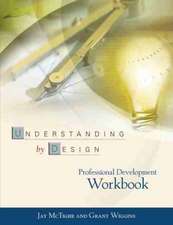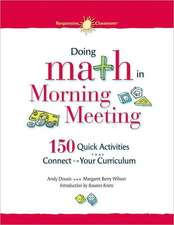From Text to 'Lived' Resources: Mathematics Curriculum Materials and Teacher Development: Mathematics Teacher Education, cartea 7
Editat de Ghislaine Gueudet, Birgit Pepin, Luc Troucheen Limba Engleză Paperback – 27 noi 2013
| Toate formatele și edițiile | Preț | Express |
|---|---|---|
| Paperback (1) | 948.61 lei 6-8 săpt. | |
| SPRINGER NETHERLANDS – 27 noi 2013 | 948.61 lei 6-8 săpt. | |
| Hardback (1) | 954.77 lei 6-8 săpt. | |
| SPRINGER NETHERLANDS – 10 sep 2011 | 954.77 lei 6-8 săpt. |
Preț: 948.61 lei
Preț vechi: 1156.84 lei
-18% Nou
Puncte Express: 1423
Preț estimativ în valută:
181.54€ • 197.12$ • 152.49£
181.54€ • 197.12$ • 152.49£
Carte tipărită la comandă
Livrare economică 22 aprilie-06 mai
Preluare comenzi: 021 569.72.76
Specificații
ISBN-13: 9789400737075
ISBN-10: 9400737076
Pagini: 384
Ilustrații: XX, 364 p.
Dimensiuni: 155 x 235 x 20 mm
Greutate: 0.54 kg
Ediția:2012
Editura: SPRINGER NETHERLANDS
Colecția Springer
Seria Mathematics Teacher Education
Locul publicării:Dordrecht, Netherlands
ISBN-10: 9400737076
Pagini: 384
Ilustrații: XX, 364 p.
Dimensiuni: 155 x 235 x 20 mm
Greutate: 0.54 kg
Ediția:2012
Editura: SPRINGER NETHERLANDS
Colecția Springer
Seria Mathematics Teacher Education
Locul publicării:Dordrecht, Netherlands
Public țintă
ResearchCuprins
Foreword: R. Sträßer, Professor of Mathematics Education, Giessen, Germany.- Introduction: G. Gueudet, B. Pepin & L. Trouche.- Section 1: Teacher resources.- Chap. 1 (J. Adler): Knowledge resources in and for school mathematics teaching.- Chap. 2 (G. Gueudet & L. Trouche): Teachers’ work with resources: documentational geneses and professional geneses.- Chap. 3 (G. Sensevy): Patterns of didactic intentions, thought collective and documentation work.- Chap. 4 (M. A. Mariotti & M. Maracci): Resources for the teacher from a semiotic mediation perspective.- Reaction to section 1: B. Barton, President of ICMI, University of Auckland, New Zealand.- Section 2: Text and Curriculum resources.- Chap. 5 (K. Ruthven): Constituting Digital Tools and Materials as Classroom Resources.- Chap. 6 (J. Remillard): Modes of Engagement: Understanding Teachers’ Transactions with Mathematics Curriculum Resources.- Chap. 7 (B. Pepin): Task analysis as ‘Catalytic Tool’ for feedback and teacher learning: Working with teachers on mathematics curriculum materials.- Chap. 8 (W. Schmidt): The Cumulative Effects of Middle School Tracking: How Content Coverage Varies.- Chap. 9 (C. Proust): Teachers’ writings and students’ writings’: school material in Mesopotamia.- Reaction to section 2: M. Swan, Professor of Mathematics Education, Shell Centre, The University of Nottingham, UK.- Section 3: Use of resources.- Chap. 10 (C. Kieran, D. Tanguay & A. Solares): Researcher-designed resources and their adaptation within classroom teaching practice.- Chap. 11 (D. Forest & A Mercier): Classroom's video data and teaching resources: Some thoughts on teacher education.-Chap. 12 (S. Rezat): Interactions of teachers' and students' use of mathematics textbooks: A study of documentational genesis.- Chap. 13 (M. Trigueros & D. Lozano): Teachers teaching mathematics with Enciclomedia.- Chap. 14 (P. Drijvers): Teachers transforming resources into orchestrations.- Reaction to section 3: L. Radford, Professor of Mathematics Education, Laurentian University in Ontario, Canada.- Section 4: Collaborative use.- Chap. 15 (C. Winsløw): A comparative perspective on teacher collaboration: the cases of lesson study in Japan and of multidisciplinary teaching in Denmark.- Chap. 16 (G. Gueudet & L. Trouche): Communities, documents and professional geneses: interrelated stories.- Chap. 17 (J. Visnovska, P. Cobb & C. Dean): Mathematics teachers as instructional designers: what does it take?.- Reaction to section 4: B. Jaworski, Chair in Mathematics Education, Loughborough University, UK.- Closing reaction: D. Lowenberg Ball, Professor in Education, Dean, School of Education, University of Michigan, USA.- Conclusion: the editors.
Recenzii
From the reviews:
“This book is clearly intended for mathematics education researchers who investigate the preparation and teaching of K–12 mathematics teachers, it would also be of interest to mathematics teacher educators and curriculum designers. … The book is organized into four parts – each part has an introductory chapter and is followed by an ‘expert’s reaction.’ … a worthwhile read for those who are interested in how teachers use a variety of resources, material and non-material, digital and non-digital.” (Annie Selden, MAA Reviews, December, 2012)
“This book is clearly intended for mathematics education researchers who investigate the preparation and teaching of K–12 mathematics teachers, it would also be of interest to mathematics teacher educators and curriculum designers. … The book is organized into four parts – each part has an introductory chapter and is followed by an ‘expert’s reaction.’ … a worthwhile read for those who are interested in how teachers use a variety of resources, material and non-material, digital and non-digital.” (Annie Selden, MAA Reviews, December, 2012)
Notă biografică
Ghislaine Gueudet is professor in mathematics didactics. She works at the University of Western Brittany in France. She is co-director of the CREAD (Center for Research on Education, Learning and Didactics). Her research concerns the interactions between teachers and resources (with a specific focus on online resources), and their consequences in terms of professional development. This theme lead her to develop, together with Luc Trouche, a documentational approach to didactics.
Web page: http://cread.bretagne.iufm.fr/spip.php?article447
Birgit Pepin is professor of mathematics didactics at Sør-Trøndelag University College in Trondheim, Norway. For many years she has worked with mathematics teachers in terms of professional development, and in different countries. One of her main research projects concerns teachers working with mathematics curriculum materials, including textbooks, in order to develop knowledge in/for teaching.
webpage: http://hist.no/content/35372/Pepin-Birgit
Luc Trouche is professor in mathematics didactics. He is director of research in the IFE (French Institute of Education), located in the ENSL (Ecole Normale Supérieure de Lyon). His research concerns the conceptualisation of mathematics in digital environments, and, more recently, with Ghislaine Gueudet, the professional development of mathematics teachers working on/with resources.
Webpage: http://educmath.inrp.fr/Educmath/recherche/educmath/page_luc_trouche/
Web page: http://cread.bretagne.iufm.fr/spip.php?article447
Birgit Pepin is professor of mathematics didactics at Sør-Trøndelag University College in Trondheim, Norway. For many years she has worked with mathematics teachers in terms of professional development, and in different countries. One of her main research projects concerns teachers working with mathematics curriculum materials, including textbooks, in order to develop knowledge in/for teaching.
webpage: http://hist.no/content/35372/Pepin-Birgit
Luc Trouche is professor in mathematics didactics. He is director of research in the IFE (French Institute of Education), located in the ENSL (Ecole Normale Supérieure de Lyon). His research concerns the conceptualisation of mathematics in digital environments, and, more recently, with Ghislaine Gueudet, the professional development of mathematics teachers working on/with resources.
Webpage: http://educmath.inrp.fr/Educmath/recherche/educmath/page_luc_trouche/
Textul de pe ultima copertă
Curriculum materials and the interaction with these materials and resources is central in teacher education and professional development. How teachers use and learn from materials fundamentally depends on the interactions between three components: the reader, the material and the context. Teachers’ use and learning from text-based materials depends to a large extent on the characteristics of the materials, on the teaching activity in which the teacher is engaged, teachers’ beliefs and knowledge, and how these are aligned with the curriculum. What kinds of curriculum materials do teachers select and use, and how? How do teachers learn from these materials, and in which ways do they ‘tailor’ them for their use and pupil learning? These factors interact in complex ways, as teachers select, interpret and shape the materials, individually and collaboratively with groups of colleagues. The characteristics of the resources shape the teacher’s activity; analysing these characteristics enlightens the mathematics presented to the students, and more generally the classroom practice and the development of teacher professional knowledge.
The purpose of this book is to provide a wider perspective on this issue in the field of mathematics education. It studies curriculum materials and their uses, in addition to investigations of teacher adaptation and use of those materials, and pays particular attention to digital resources. Teacher’s professional activity is studied as a whole, at different moments and in different contexts, in-class and out-of-class, with a variety of agents. The collective dimensions of this activity, the role of a variety of collectives for teachers professional development, constitute a major focus of the work presented here.
The purpose of this book is to provide a wider perspective on this issue in the field of mathematics education. It studies curriculum materials and their uses, in addition to investigations of teacher adaptation and use of those materials, and pays particular attention to digital resources. Teacher’s professional activity is studied as a whole, at different moments and in different contexts, in-class and out-of-class, with a variety of agents. The collective dimensions of this activity, the role of a variety of collectives for teachers professional development, constitute a major focus of the work presented here.
Caracteristici
The book addresses both secondary and primary teachers and curricula Draws from research in several countries, and authors with diverse expertise Connects the design of curricula and the use of curricula by teachers

















